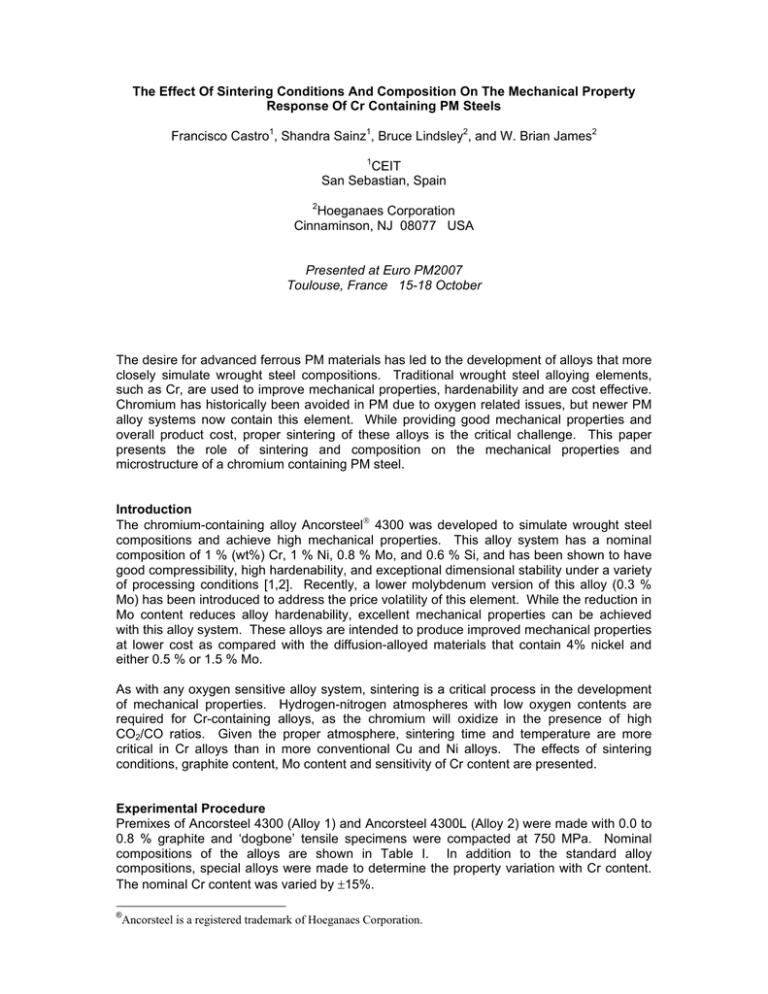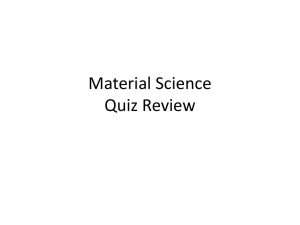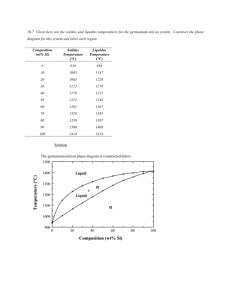The Effect Of Sintering Conditions And Composition On The Mechanical... Response Of Cr Containing PM Steels
advertisement

The Effect Of Sintering Conditions And Composition On The Mechanical Property Response Of Cr Containing PM Steels Francisco Castro1, Shandra Sainz1, Bruce Lindsley2, and W. Brian James2 1 CEIT San Sebastian, Spain 2 Hoeganaes Corporation Cinnaminson, NJ 08077 USA Presented at Euro PM2007 Toulouse, France 15-18 October The desire for advanced ferrous PM materials has led to the development of alloys that more closely simulate wrought steel compositions. Traditional wrought steel alloying elements, such as Cr, are used to improve mechanical properties, hardenability and are cost effective. Chromium has historically been avoided in PM due to oxygen related issues, but newer PM alloy systems now contain this element. While providing good mechanical properties and overall product cost, proper sintering of these alloys is the critical challenge. This paper presents the role of sintering and composition on the mechanical properties and microstructure of a chromium containing PM steel. Introduction The chromium-containing alloy Ancorsteel® 4300 was developed to simulate wrought steel compositions and achieve high mechanical properties. This alloy system has a nominal composition of 1 % (wt%) Cr, 1 % Ni, 0.8 % Mo, and 0.6 % Si, and has been shown to have good compressibility, high hardenability, and exceptional dimensional stability under a variety of processing conditions [1,2]. Recently, a lower molybdenum version of this alloy (0.3 % Mo) has been introduced to address the price volatility of this element. While the reduction in Mo content reduces alloy hardenability, excellent mechanical properties can be achieved with this alloy system. These alloys are intended to produce improved mechanical properties at lower cost as compared with the diffusion-alloyed materials that contain 4% nickel and either 0.5 % or 1.5 % Mo. As with any oxygen sensitive alloy system, sintering is a critical process in the development of mechanical properties. Hydrogen-nitrogen atmospheres with low oxygen contents are required for Cr-containing alloys, as the chromium will oxidize in the presence of high CO2/CO ratios. Given the proper atmosphere, sintering time and temperature are more critical in Cr alloys than in more conventional Cu and Ni alloys. The effects of sintering conditions, graphite content, Mo content and sensitivity of Cr content are presented. Experimental Procedure Premixes of Ancorsteel 4300 (Alloy 1) and Ancorsteel 4300L (Alloy 2) were made with 0.0 to 0.8 % graphite and ‘dogbone’ tensile specimens were compacted at 750 MPa. Nominal compositions of the alloys are shown in Table I. In addition to the standard alloy compositions, special alloys were made to determine the property variation with Cr content. The nominal Cr content was varied by ±15%. ® Ancorsteel is a registered trademark of Hoeganaes Corporation. Table I. Nominal compositions of the alloys. ID Fe (wt.%) Mo (wt.%) Cr (wt.%) Ni (wt.%) Si (wt.%) Gr (wt.%) Alloy 1 Bal. 0.8 1.0 1.0 0.6 0.0-0.8 Alloy 2 Bal. 0.3 1.0 1.0 0.6 0.0-0.8 The laboratory specimens were sintered in a batch furnace for either 15 or 30 minutes at 1120 °C in an atmosphere of 90N2-10H2 (vol.%). Additional samples were also sintered for 15 minutes at 1160 °C. Temperature was measured using a thermocouple embedded in a test bar. Time at temperature was recorded when the sample was within 5 °C of the set temperature. Three average cooling rates, measured between 650 and 315 °C, were obtained during the study: 0.45, 2, and 3.7 °C/sec. An inert gas quench was used to obtain the higher cooling rates. Industrial sintering trials were conducted in standard belt furnaces with hydrogen – nitrogen atmospheres. A tempering temperature of 205 °C for 1 hour was used for all samples. Results and Discussion Figure 1 shows the effect of carbon content on the tensile curves for both the Ancorsteel 4300 and lean 4300 (0.3% Mo) alloys. Both alloys contain nominally 0.85% Cr, and while less than the Cr composition limits for Ancorsteel 4300 (Alloy 1), this represents a lower limit to the mechanical properties of Alloy 1. The alloys respond as expected with increasing graphite content; increased carbon increases strength and reduces ductility. The effect of Mo content is also apparent in the graphs. Alloy 1 has higher strength than the lower Mo Alloy 2. The graphite content can be tailored to achieve similar properties with the different Mo contents. For example, the 0.4% graphite, 0.3%Mo alloy would be similar to a 0.25% graphite, 0.8% Mo alloy. If high yield strength with limited ductility is desirable, then the 0.8% graphite, 0.3% Mo alloy can be used in lieu of the 0.6% graphite, 0.8%Mo alloy, yielding considerable savings with the reduction in Mo content. Given that there is little variation in the dimensional change of the Ancorsteel 4300 system with graphite content [2], carbon can be easily used to achieve a range in mechanical properties. The effect of sintering time and temperature has been discussed with these alloy systems in the literature, although no systematic study has been performed previously to show these effects in combination with different graphite contents. The results of the present sintering studies can been found in Table II. It is somewhat surprising that little change in tensile properties were found as the sintering time was increased from 15 to 30 minutes at 1120 °C for the 0.8% Mo alloy. Prior work has found this alloy to be sintering time sensitive. One can see that the best properties are obtained at 1160 °C, where both the yield and ultimate tensile strength improve for all conditions. The effect of sintering time is much more dramatic for Alloy 2 (0.3% Mo), Table III. The improvement in strength is hundreds of MPa with little change in elongation. Ensuring that the material is at temperature for a full 30 minutes is critical to achieve the potential mechanical properties of this material system. 1000 0.6 0.5 0.4 0.8 Stress (MPa) 800 0.3 0.2 600 0.1 0.0 400 200 0 0 2 4 6 8 10 12 14 Elongation (%) (a) 1000 0.6 0.8 0.5 Stress (MPa) 800 0.4 0.3 600 0.2 0.1 0.0 400 200 0 0 2 4 6 8 10 12 14 Elongation (%) (b) Figure 1. The effect of carbon content on the tensile properties of (a) Ancorsteel 4300 and (b) Ancorsteel 4300L (0.3% Mo). Samples sintered at 1120 °C for 30 minutes and cooled at 0.45 °C/s. Table II. Effect of sintering time and temperature on yield (σy) and ultimate tensile (UTS) strength for Alloy 1 (0.8% Mo, 0.85% Cr). Units are in MPa. 1120 °C, 15 min 1120 °C, 30 min 1160 °C, 15 min %C UTS UTS UTS σy σy σy 0 156 333 161 427 239 478 0.1 192 407 275 578 400 632 0.2 459 689 430 690 532 727 0.3 556 807 549 792 608 832 0.4 629 874 621 847 679 889 0.5 674 933 657 942 718 973 0.6 756 956 741 994 808 1048 Table III. Effect of sintering time and temperature on yield (σy), ultimate tensile (UTS) strength and elongation for Alloy 2 (0.3% Mo, 0.85% Cr). Strength units are in MPa. 1120 °C, 15 min 1120 °C, 30 min %C UTS % Elong UTS % Elong σy σy 0 161 329 11.7 142 371 13.6 0.1 186 361 9.1 194 463 8.3 0.2 221 414 7.9 285 569 7.9 0.3 288 470 5.8 311 631 5.7 0.4 362 541 5.3 427 742 4.6 0.5 452 642 4.5 563 892 4.1 0.6 491 670 4.1 588 920 3.3 The data above were generated at the lowest cooling rate and had lower than normal Cr levels, so they represent the low end of strength that can be obtained with these alloys. The data for the standard Ancorsteel 4300 composition (Alloy 1 - 1% Cr, 0.8% Mo) have been plotted as a function of cooling rate, Figure 2. The data from reference 2 has also been included and good agreement was found. Recall that the current study was conducted in a batch-type furnace, whereas the reference data was generated in a belt furnace. The reference data were generated at a density of 7.1 g/cm3. Figure 2. Effect of cooling rate on the mechanical properties of Alloy 1 (1% Cr, 1% Ni, 0.8% Mo, 0.6% Si). Typical microstructures are found in Figure 3. These alloys generally contain a mixture of martensite and bainite / divorced pearlite at conventional cooling rates. With accelerated cooling, Alloy 1 (0.8%Mo) fully sinterhardens, whereas the lower Mo content Alloy 2 requires very rapid cooling rates or higher C contents to fully sinterharden. At 2 °C/s, Alloy 2 contains 70-80% martensite. Figure 3. Effect of Mo content on the microstructure of 1% Cr, 1% Ni, 0.6% Si alloys sintered at 1120 °C for 30 minutes and cooled at 2 °C/s. a) 0.3% Mo (Alloy 2), b) 0.8% Mo (Alloy 1). As stated in the introduction, the Cr-containing steels were designed to compete with the higher cost diffusion-alloyed steels. Data from the literature [3] of two diffusion-alloyed steels sintered at 1120 °C and cooled at 2 °C/s are compared with the data of this work (Table IV). It can be seen in Table IV that the Cr alloys have significantly higher yield and tensile strengths than the two diffusion-alloyed steels. Given that cooling rates can be calculated over different temperature ranges, the data may not be directly comparable. Nevertheless, even when the data are compared with the slowest cooling rates used in this study, Alloys 1 and 2 outperform both the 0.5% Mo and the 1.5% Mo diffusion-alloyed steels. Table IV. Comparison of the Cr-containing alloy properties generated in the current study vs. diffusion-alloyed steel properties from [3] and [4]. Sintered densities are 7.1 ± 0.05 g/cm3. Cooling Rate UTS σy % Elong Alloy (MPa) (MPa) (°C/s) Alloy 1 2 1065 1210 1.2 (0.6% graphite) 1.5%Mo, 4%Ni, 2 640 [3] 850 [3] 0.8 [3] 2%Cu, 0.65%C 530 [4] 860 [4] 1.0 [4] Alloy 2 2 795 1005 1.4 (0.6% graphite) 0.5%Mo, 4%Ni, 2 410 [3] 600 [3] 2.0 [3] 2%Cu, 0.65%C 460 [4] 710 [4] 1.0 [4] Alloy 1 0.45 740 990 2.0 (0.6% graphite) Alloy 2 0.45 670 1000 3.1 (0.6% graphite) %C 0.5 0.6 0.5 0.6 Table V. Effect of Cr and Mo content on tensile properties at 3.7 °C/s. 0.8% Mo, 0.85% Cr 0.3% Mo, 0.85% Cr UTS % Elong UTS % Elong σy σy 1090 1175 1.1 690 960 1.8 1125 1205 1.2 820 1015 1.3 0.8% Mo, 1.15% Cr 0.3% Mo, 1.15% Cr 1075 1310 1.4 750 1095 2.1 1200 1280 1.1 830 1075 1.4 The effect of Cr content can be seen in Table V. The high and low Cr contents are shown and bracket the standard alloy composition. With 0.6% graphite, less than a 10% improvement in yield and tensile strength was found from the low to high Cr range for both Mo contents. With 0.5% graphite, a similar response was found with the yield strength, but the elongation and tensile strength showed a much greater change, with strengths increasing more than 10%. The data suggests an interaction between C and Cr content in the alloys, where more chromium can be used at lower carbon contents. Industrial Sintering Trials Industrial sintering trials were conducted to confirm the sintering response of these alloys in a commercial sintering environment. Tensile specimens were pressed to the same density and sintered at 1120 °C for nominally 30 minutes in a nitrogen-hydrogen environment with conventional cooling. Samples were tempered at 205 °C for 1 hour. The table below shows the average values for both the 0.3% and 0.8% Mo alloys. It can be seen that the yield strengths are slightly higher compared with the laboratory results at 0.45 °C/s suggesting a faster cooling rate in the belt furnace. The elongation and ultimate tensile strengths are, however, lower, indicating the samples may not have been at temperature for 30 minutes in the industrial trial. Overall, the industrial trials match the laboratory results reasonably well. Table VI. Comparison of tensile properties generated using industrial mesh belt and laboratory batch furnace sintering. 0.3% Mo (Alloy 2), 0.6% graphite 0.8% Mo (Alloy 1), 0.6% graphite UTS Total UTS Total σy σy Sintering (MPa) Elong. (%) (MPa) Elong. (%) (MPa) (MPa) Industry 680 920 2.4 785 950 1.5 Laboratory 670 1000 3.1 740 990 2.0 Conclusions Chromium alloys can be effectively sintered in nitrogen-hydrogen atmospheres at conventional sintering temperatures, as was found in both laboratory and industrial sintering trials. Ancorsteel 4300 and Ancorsteel 4300L were found to have superior tensile strengths compared to the diffusion-alloyed steels containing 4% Ni. The strength properties were relatively insensitive to Cr content with 0.6% admixed graphite, whereas a larger effect was found in the 0.5% graphite alloy. Generally, the Cr content becomes more important as the Mo level is driven down. As expected, an increase in cooling rate improves the strength of these alloys and makes the Cr-containing alloys well suited for sinter-hardening applications at intermediate (0.6%) carbon contents. References 1. King, P. and Lindsley, B., “A New Cr-Bearing Alloy for High Performance Applications,” Advances in Powder Metallurgy & Particulate Materials, MPIF, Princeton, NJ, 2005. 2. King, P. and Lindsley, B., “Performance Capabilities Of High Strength Powder Metallurgy Chromium Steels With Two Different Molybdenum Contents” Advances in Powder Metallurgy & Particulate Materials, MPIF, Princeton, NJ, 2006. 3. L. Sigl, P. Delarbre, K. Lipp, C. M. Sonsino, “Static And Fatigue Properties Of High Strength PM Steels”, Euro PM2005, EPMA, 2005, vol. 1, p. 151. 4. MPIF Standard 35 – Materials Standards for PM Structural Parts, revision 2007, published by MPIF, 2007, p. 46.






